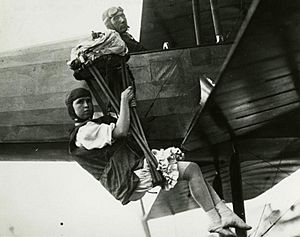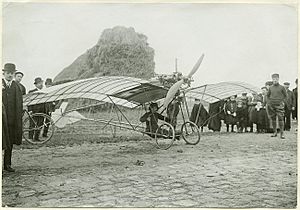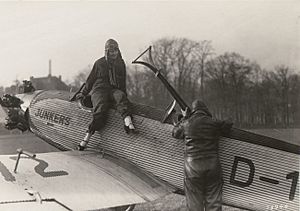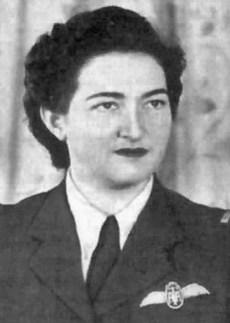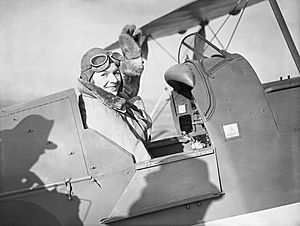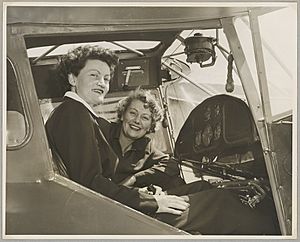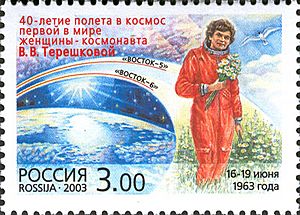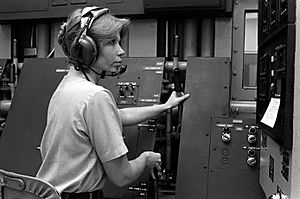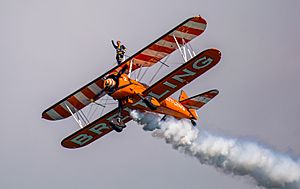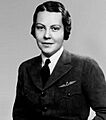Women in aviation facts for kids
Women have been flying since the very beginning of aviation, from hot air balloons to airplanes and even into space! Early women pilots were sometimes called "aviatrices." Women started flying powered aircraft in 1908. For a long time, before the 1970s, most women could only fly privately or in support roles. Aviation also gave women amazing chances to travel alone. Successful women in aviation often helped younger women learn and grow in their careers.
In the first 20 years of powered flight, women pilots were already setting new records for speed, how long they could stay in the air, and how high they could fly. They competed against men in air races and often won! Women on every continent except Antarctica began to fly, perform in airshows, parachute, and even carry passengers. During World War II, women from all over the world helped with war efforts. Many flew in support services, even though they were mostly not allowed to fly in combat. In the 1950s and 1960s, women mainly worked in support jobs like flight simulation training, air traffic control, and as flight attendants. Since the 1970s, women have been allowed to join military flight roles in most countries.
More and more women have joined the world of aviation over the years. In 1909, Marie Surcouf started the first group for female pilots, called the Aéroclub féminin la Stella. After the first women-only air race in the United States in 1929, 99 of the 117 women with U.S. pilot licenses formed the first American female pilot group, the Ninety-Nines. It was named after the number of founding members. By 1930, there were about 200 women pilots in the U.S., and within five years, there were over 700! However, after 1980, the number of women pilots in the United States has not grown much. Globally, only about 3% of airline pilots are women. While the total number of female pilots has increased, the percentage compared to men remains low.
| Women in aviation | |
|---|---|
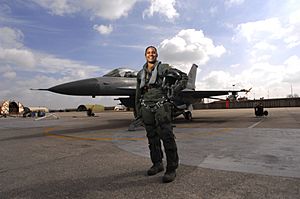 |
|
| Shawna Kimbrell, the United States Air Force's first African American female fighter pilot |
Contents
A Look Back: Women's Aviation History
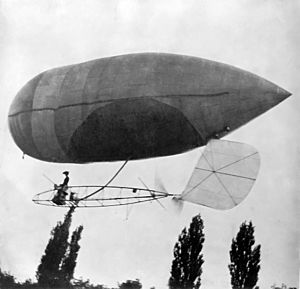
The first woman known to fly was Élisabeth Thible. She was a passenger in a hot air balloon that floated over Lyon, France, in 1784.
Four years later, Jeanne Labrosse became the first woman to fly a balloon alone. She was also the first woman to use a parachute! Sophie Blanchard took her first balloon flight in 1804. By 1810, she was a professional balloonist. Napoleon even made her his chief of air service in 1811. Sadly, Blanchard died in 1819 when her balloon caught fire.
In June 1903, Aida de Acosta, an American woman visiting Paris, convinced Alberto Santos-Dumont to let her fly his airship. She was likely the first woman to pilot a motorized aircraft.
Starting in 1906, E. Lilian Todd began designing her own airplanes. Her first plane flew in 1910, piloted by Didier Masson. Early parachutist Tiny Broadwick started working with a stunt flyer at age 15 in 1908. She made her first jump that year. In 1913, she became the first woman to jump from an airplane. Broadwick even showed the U.S. government how parachutes worked in 1914. When she retired in 1922, she had made 1,100 jumps!
The first woman passenger in an airplane was Mlle P. Van Pottelsberghe de la Poterie. She flew with Henri Farman in Belgium in 1908. Soon after, in July 1908, French sculptor Thérèse Peltier flew as a passenger. Within months, she was reported to have flown alone in Italy. Edith Berg, an American, flew with Wilbur Wright in Paris in October 1908.

The Wright brothers made the first machine-powered flight on December 17, 1903. Their sister, Katharine Wright, helped them a lot. She found teachers for their experiments and knew "everything about the working of their machines." Katherine also supported them financially and emotionally. When Orville Wright was hurt in 1908, Katherine moved to be near him. After the brothers patented their aircraft in 1906, she became their executive secretary. In 1909, she went to Europe to help promote their work. The French government gave her a high honor in 1909. Katherine was called the "silent partner" and "inspiration" of the Wright Brothers. However, Orville Wright was very upset when she got married. She died less than a year later.
Early 1910s: Women Take Flight
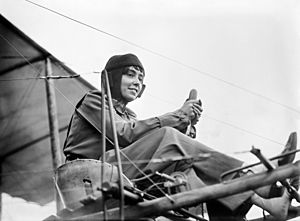
In 1910, French pilot Raymonde de Laroche became the first woman in the world to earn a pilot's license. A license was needed to fly commercially and in airshows. Seven other French women got their licenses within the next year. One of them, Marie Marvingt, became the first woman to fly in combat, dropping bombs over Germany. She also tried to get air ambulances before the war and became the world's first certified Flight nurse.
Hélène Dutrieu became the first woman pilot in Belgium in 1910. Later that year, she was the first woman to fly with a passenger. In 1910, before getting her license, Lilian Bland from Northern Ireland designed and flew a glider in Belfast.
Blanche Scott often said she was the first American woman to fly an airplane. However, her short flight in September 1910 was "accidental" because a gust of wind lifted her plane. She later became known as the "Tomboy of the Air," performing daring stunts in airshows. On October 13, 1910, Bessica Raiche received a medal for being the first American woman to make a solo flight. In 1910, the Femina Cup was created in France to honor the female pilot who made the longest flight each year.
Harriet Quimby became the USA's first licensed female pilot on August 1, 1911. The next year, she was the first woman to fly across the English Channel. Thirteen days after Quimby, her friend Matilde E. Moisant also got her license and started flying in airshows.
Soon after, Lydia Zvereva got the first female Russian license. By 1914, she performed the first aerobatic loop by a woman. Hilda Hewlett became the first British woman to earn a pilot's license on August 29, 1911. She even taught her son to fly! Cheridah de Beauvoir Stocks was the second British woman to get a pilot's license in 1911.
In September 1910, Melli Beese became Germany's first woman pilot. The next year, she began designing her own airplane. On October 10, 1911, Božena Laglerová from Prague got the first Austrian license for a woman. Nine days later, she got the second German license for a woman. On December 7, 1910, Jane Herveu was licensed in France and started competing in the Femina Cup. Lilly Steinschneider became the first female pilot in the Austro-Hungarian Empire on August 15, 1912.
Rosina Ferrario, Italy's first female pilot, earned her license in 1913. Like Marvingt, she tried to get her government to let women transport wounded soldiers during World War I, but was unsuccessful. Elena Caragiani-Stoenescu, Romania's first woman pilot, got the same response and turned to journalism. On December 1, 1913, Lyubov Golanchikova became the first female test pilot. The first woman in Africa to earn a pilot's license was Ann Maria Bocciarelli of Kimberley, South Africa.
In 1916, Zhang Xiahun became China's first female pilot. She crashed after circling a field and tossing flowers, but survived and became a national hero. Katherine Stinson became the first woman air mail pilot in 1918, flying mail from Chicago to New York City. The next year, Ruth Law flew the first official U.S. air mail to the Philippines.
Women also helped teach others to fly. Hilda Hewlett and Gustav Blondeau started the first flying school in England in 1910. Charlotte Möhring, the second German woman to get a pilot's license, managed a flying school in 1913.
1920s: Stunts and Organizations
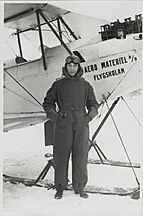
After World War I, many men and women bought extra planes from the military. They traveled from town to town, offering rides and performing stunts like loops and wing walking to attract crowds. These daring pilots formed "flying circuses."
In 1920, 18-year-old Phoebe Omlie decided to become a stuntwoman in aviation. By 1921, she set a world record for a women's parachute drop (15,200 feet). She also worked as a wing walker for movies. By 1927, Omlie earned the first transport pilot's license and airplane mechanics license given to a woman. Another stuntwoman, Ethel Dare, was the first woman to walk from one plane to another in 1920.

In 1928, Eileen Vollick was the first woman in Canada to get a pilot's license. Japan's first woman pilot, Tadashi Hyōdō, earned hers the same year. Karolina Borchardt from Poland also got her license in 1928. Kwon Ki-ok of Korea became her country's first female licensee in 1925. After World War II, she helped create the Republic of Korea Air Force. German pilot Marga von Etzdorf was the first woman to fly for an airline, Lufthansa, starting in 1927.
In the late 1920s, women kept competing in cross-country air races. In 1929, Pancho Barnes moved to Hollywood to be the first woman stunt pilot. She worked on films like Howard Hughes' Hell's Angels (1930). She also started the Associated Motion Pictures Pilots Union in 1931.
The first Women's Air Derby, also called the Powder Puff Derby, was a women-only race from Santa Monica, California to Cleveland, Ohio. It was part of the 1929 National Air Races and was won by Louise Thaden. Marie Marvingt of France continued to promote her idea of using airplanes as ambulances. During French colonial wars, Marvingt used a flying ambulance service to help injured soldiers. Canadian Eileen Vollick became the first licensed female pilot in 1928 at age 19. Elsie MacGill became the first woman to earn a master's degree in aeronautical engineering in 1929.
Janet Hendry became the first woman pilot in Scotland, getting her license in December 1928.
On November 2, 1929, 26 women pilots met in New York and formed an international group to support each other. They called themselves the Ninety-Nines, after their 99 founding members.
1930s: Breaking New Ground
The 1929 stock market crash and the Great Depression made it harder for flying circuses to continue. During this time, women pilots in the United States mostly worked in sales, marketing, racing, and as instructors. In 1930, Ellen Church, a pilot who couldn't find flying work, suggested that airlines hire women as hostesses. She was hired by Boeing Air Transport and became one of the first seven flight attendants. These first flight attendants had to be under 115 pounds, nurses, and unmarried.
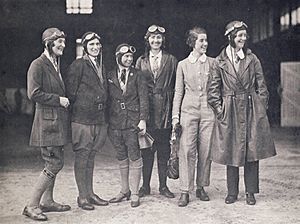
Many "firsts" were achieved by women in the 1930s. In 1930, English aviator Amy Johnson made the first flight from England to Australia by a woman. The same year, Mrs Victor Bruce became the first person to fly from England to Japan. She was also the first woman to fly around the world alone (crossing oceans by ship).
Antonie Strassmann, a German pilot, became the first woman to successfully cross the Atlantic in an aircraft in May 1932. Later that year, Strassmann piloted a Zeppelin from Germany to Brazil.
In May 1932, American Amelia Earhart became the first woman to fly solo across the Atlantic. She encouraged young women to become pilots. In 1936 and 1937, she taught at Purdue University, one of the few U.S. colleges offering aviation classes to women.
In 1933, Lotfia ElNadi became the first Egyptian and first Arab woman to earn a pilot's license. That same year, Marina Raskova became the first Russian woman navigator for the Soviet Air Forces. The next year, she became the first female instructor at the Zhukovsky Air Force Engineering Academy.
Hazel Ying Lee, an American-Chinese citizen, got her pilot's license in the U.S. in 1932. She offered to serve in the Chinese Army after the Japanese invasion, but was turned down because she was a woman. In 1934, Chinese actress Lee Ya-Ching got a pilot's license in Switzerland. The next year, she got the first license for a woman from the American Boeing School of Aeronautics. In 1936, she became the first woman licensed by China as a pilot and founded a flying school in Shanghai.
In 1935, Nancy Bird Walton got the first Australian license allowing a woman to carry passengers. She used it to fly an ambulance service for children. She later founded the Australian Women Pilots' Association.
That same year, Phyllis Dunning earned the first women pilot's license in South Africa. The next year, she became the first female commercial pilot. Within two years, she was the first South African woman flight instructor.
In France, Suzanne Melk was the first known woman in her country to fly and the first woman in Europe to receive a pilot's license in 1935.
Sarla Thakral was the first Indian woman to fly, earning her pilot license in 1936. She later flew over 1000 hours.
In 1936, Hanna Reitsch of Germany became one of the first people to fly a fully controllable helicopter. Within two years, she earned the first woman helicopter pilot's license.
Women had been banned from the famous Bendix Trophy race after a pilot's death, but were allowed to compete again from 1935. In 1936, women won first, second, and fifth place. The winners were Louise Thaden and Blanche Noyes. Laura Ingalls came second, and Earhart was fifth. In 1938, Jacqueline Cochran won the race.
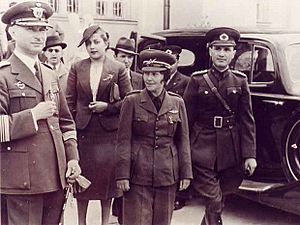
In 1936, Sabiha Gökçen of Turkey became the first trained woman combat pilot. She took part in search and bombing flights during the Dersim rebellion. While other women had been involved in military operations, she was the first to be trained as a military pilot. She flew about 8,000 hours and participated in 32 different military operations.
In 1939, the South African Women's Aviation Association (SAWAA) was formed with 110 women. By the end of the year, it had grown to 3000-4000 members. When war broke out, it became the Women's Auxiliary of the South African Air Force.
1940s: Women in World War II
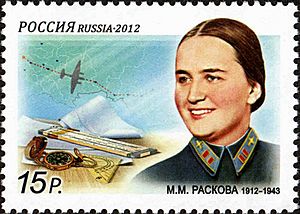
As World War II began, women became involved in combat roles. In the United States, pilots usually flew only in good weather. But combat flying needed pilots to fly in all conditions, so instrument training became important. By 1944, about 6,000 women were trained as Link Trainer operators, teaching male pilots how to read instruments. Women like Patricia W. Malone later became commercial flight simulation instructors.
In 1939, Jacqueline Cochran suggested to First Lady Eleanor Roosevelt that women pilots could help the military. Later, Nancy Harkness Love made a similar request. Both ideas were put on hold until 1942. Love was then put in charge of the Women's Auxiliary Ferrying Squadron (WAFS). This group became known for its quiet efficiency. On September 14, 1942, General Henry H. Arnold put Cochran in charge of a new program, the Army Air Forces Women's Flying Training Detachment (WFTD). By August 5, 1943, the WFTD and WAFS joined to form the Women Airforce Service Pilots (WASP). The WASPs helped the military by flying new planes from factories to bases, working as test pilots, flying as chauffeurs, and towing targets for anti-aircraft practice. The WASPs never got full military benefits and were disbanded in December 1944. They finally earned veteran status in 1979.
Besides flying, American women also became air traffic controllers during WWII. Commander Frances Biadosz was the only WAVE to wear wings for air-navigation during the war. Women were also hired by the National Advisory Committee for Aeronautics (NACA) as scientists and engineers. They reviewed data from windtunnels on airplane designs.
In 1940, Major Phyllis Dunning became the first South African woman to join full-time military service. She was the Commander of the South African Women's Auxiliary Air Force (SAWAAF). In 1941, the Southern Rhodesia Women's Auxiliary Air Service was created. Within months, over 100 women recruits provided clerical services, sewing, parachute packing, and worked as drivers, equipment assistants, and mechanics.
The Air Transport Auxiliary (ATA), a British civilian group during WWII, had 166 women pilots. This was one in eight of all ATA pilots, led by Pauline Gower. The first eight women pilots joined on January 1, 1940. Fifteen of these women pilots died while flying, including British aviator Amy Johnson. Ida Veldhuyzen van Zanten was the only Dutch woman in the ATA. Margot Duhalde, a woman from Chile, flew transport missions for the ATA. After the war, she became the first woman pilot of the French Air Force. For her service, Duhalde was made a Knight of the Legion of Honour in 1946. Valérie André, a neurosurgeon in the French army, became the first woman to fly a helicopter in combat in Indochina (1945). The Royal Canadian Air Force created a Women's Division in 1942. Women earned 2/3 the pay of men. They were not allowed to fly in combat, but they did aircraft maintenance, air traffic control, and other duties. By the end of the war, over 17,000 Canadian women had served.
Korean pilot Lee Jeong-hee, who got her license in 1927, joined the Republic of Korea Air Force in 1948. She was the founding commander of the Women's Air Force Corps in 1949.
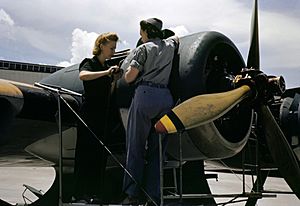
Unlike other countries, the Soviet Union created an all-woman combat flight unit, the 588th Night-Bomber Air-Regiment, also known as the Night Witches. This group flew bombing missions from 1942 until the end of WWII. All the women were volunteers. The Night Witches flew 30,000 missions and dropped 23,000 tons of bombs. They were honored for their bravery. The Soviets also had the only women considered flying aces. Lydia Litvyak was credited with 12 solo kills and 3 shared kills. Yekaterina Budanova fought over Saratov and Stalingrad and was credited with 11 kills.
In 1948, Ada Rogato, Brazil's first licensed woman pilot, became the first female agricultural pilot. She was hired by the government to spray coffee fields. The next year, Rogato became the first woman to fly solo over the Andes. In 1951, she flew from Tierra del Fuego to Alaska, a solo flight across three continents. In 1948, Isabella Ribeiro de Cabral became the first woman pilot of Trinidad and Tobago. It took another forty years, until 1988, for the first Trinidadian woman, Wendy Yawching, to become a captain.
1950s: Breaking Barriers
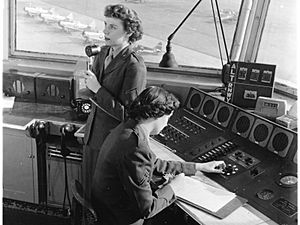
In 1951, China's People's Liberation Army Air Force (PLAAF) enrolled 55 women trainees. When they graduated, 14 became pilots, and others became communication operators, navigators, and mechanics. A second class of 160 trainees entered PLAAF in 1956, but only 44 finished training.
In late 1952, during the Korean War, the North Korean Air Force was the only one with female jet fighter pilots. One of them, Tha Sen Hi, flew MiG-15s in combat and became a squadron leader. She was honored as a Hero of the Korean People's Democratic Republic.
In 1952, Earsley Barnett earned the first pilot license given to a woman in Jamaica. She later became the first Jamaican flight instructor and a commercial pilot.
Jacqueline Cochran became the first woman to break the sound barrier in 1953. She had to use a Canadian jet because the U.S. military wouldn't let her use American aircraft. By June 1953, she held almost all the world speed records for women. On June 14, 1963, Jacqueline Auriol became the first woman to fly at twice the speed of sound.
During the Korean War, former WASPs were asked to join the United States Air Force. By 1952, 13% of women recruits were chosen for air training, including air control and electronics. In 1953, the WAVES allowed women to serve as mechanics. Kim Kyung-Oh was the only South Korean woman to serve as a pilot in the ROK Air Force during the Korean War.
Organizations like the Australian Women Pilots' Association (AWPA) were formed. Another group, the Whirly-Girls, was started by Jean Ross Howard Phelan in 1955 for women helicopter pilots. She created the group to help members connect and support each other in a field mostly dominated by men.
Pakistan based its air force on the British Royal Air Force in the late 1950s. This allowed more women to join the military in Pakistan. In 1958, Dorothy Rungeling of Canada became her country's first woman to pilot a helicopter alone.
In the 1950s and 1960s, air travel was expensive. U.S. segregation laws were slowly being removed, opening up travel and job opportunities. More workers from India and the Caribbean, along with independence movements in Africa and the Caribbean, led to a need for workers in Britain after the war. The next decades saw more women from former colonies enter aviation.
1960s: Glamour and Space
In the 1960s, stewardesses (female flight attendants) were seen as glamorous adventurers. Songs and movies made them seem stylish and romantic. They wore custom uniforms and were career women. However, their looks, marital status, and whether they had children were controlled by airline executives. They were expected to look perfect but were also used to sell airline travel through their appearance. This double standard was highlighted in the popular 1967 book, Coffee, Tea or Me? In 1963, stewardesses held a press conference about airlines forcing them to retire at age 32. This brought attention to the airlines' strict ideas of "feminine allure."
In 1960, Olga Tarling became the first woman air traffic controller in Australia. Yvonne Sintes and Frankie O'Kane became the first female British air traffic controllers. That same year, Alia Menchari became the first woman Tunisian pilot. In 1961, Lucille Golas got the first pilot license for a woman in Guyana to help her husband's mining business. Asegedech Assefa became the first Ethiopian woman to earn a pilot's license in 1962. That same year, Jacqueline Cochran became the first woman to fly a jet across the Atlantic Ocean. She was also the first woman to break the sound barrier. Throughout the decade, she and Jacqueline Auriol of France competed for women's speed and distance records. Jacqueline Auriol was the first woman to fly at twice the speed of sound in 1963.
A private project, the Woman in Space Program, recruited women pilots in the U.S. to see if they could go to space. Thirteen women passed NASA's physical tests. However, the United States Navy canceled further testing because NASA officials were not involved. Public hearings were held in 1962. Since NASA required astronauts to have engineering degrees and be military jet pilots, none of the women could meet the requirements. No action was taken after the hearing. The next year, Valentina Tereshkova, a Russian parachute jumper, became the first woman in space.
In 1963, Betty Miller became the first woman to fly solo across the Pacific Ocean. Anne Spoerry, a French doctor in Kenya, became the first female member of the African Medical and Research Foundation's "Flying Doctors." She flew her plane through remote areas to provide medical help.

In 1964, Jerrie Mock became the first woman to fly solo around the world. She flew her plane, Spirit of Columbus, in 29 and a half days. In 1966, Soviet pilot Galina Gavrilovna Korchuganova won gold at the World Aerobatic Championship, becoming the first women's world aerobatics champion.
Because the Vietnam War was unpopular in the United States, not enough men were volunteering for the military. Many women wanted to join, but were turned away due to limits on women's military roles. In 1967, a law was passed allowing more women into the military and to be promoted to higher ranks. In 1969, Kucki Low got the first pilot's license issued to a woman in South West Africa (now Namibia). That same year, Turi Widerøe of Norway became the first female pilot for Scandinavian Airlines. She is still recognized as the Western world's first woman commercial pilot for a major airline.
1970s: Military and Commercial Opportunities
Before the 1970s, aviation was mostly a male job in the United States. Rules often required pilots to have flown in the military to get enough flight hours. Until the 1970s, the U.S. Air Force and Navy did not allow women to fly. Women were also usually denied jobs in commercial piloting. The U.S. military did not allow women to fly fighter jets until 1993. Women began to enter U.S. major commercial aviation in the 1970s and 1980s. In 1973, the first female pilot was hired by a major U.S. airline, American Airlines. American also promoted the first female captain of a major U.S. airline in 1986. The next year, they had the first all-woman flight crew. In other countries, like with Turi Widerøe at Scandinavian Airlines System (hired in late 1968) and Aeroflot, women pilots were already being hired.
In the 1970s, women were allowed to fly in the United States Armed Forces again, for the first time since WWII. This started with the Navy and Army in 1974, and then the Air Force in 1976. By the mid-1970s, women predicted a big increase in female pilots because of the women's liberation movement. Louise Sacchi was the first international woman ferry pilot. She flew planes across the Atlantic and Pacific oceans over 340 times, more than any other non-airline pilot. In 1971, she set a women's speed record, flying from New York to London in 17 hours and 10 minutes. Sacchi was the first woman to win the Godfrey L. Cabot Award for service to aviation. The first class of ten female Air Force officers earned their Silver Wings on September 2, 1977. In 1978, former WASPs formed the Women's Military Pilots Association (WMPA).
In 1975, Yola Cain became the first Jamaican-born commercial pilot and flight instructor. The next year, Cain became the first female pilot with the Jamaica Defence Force. In the 1980s, she became the first woman pilot for TransJamaica Ltd.. Four years later, in 1979, Jamaican Maria Ziadie-Haddad became one of the first women in the Western Hemisphere to be a commercial jet airline pilot. She was hired as the first woman pilot of Air Jamaica. Another Jamaican, Michele Yap, became the first female airline captain in the Caribbean in 1988. The next year, Captain Yap was the first to pilot an all-female crew in the Anglo-Caribbean.
On September 9, 1976, Asli Hassan Abade made her first solo flight as the only female pilot in the Somali Air Force. In 1977, Cheryl Pickering-Moore and Beverley Drake of Guyana became the first two women pilots of the Guyana Defence Force. Drake later became the first female pilot of the Guyana Airways Corporation. In the 1990s, she became the first woman and African-American senior inspection analyst for the U.S. National Transportation Safety Board. Jill Brown-Hiltz joined Texas International Airlines as a pilot in 1978, becoming the first African American woman to fly for a commercial airline in the United States. That same year, Chinyere Kalu became Nigeria's first female pilot. In 1979, Koh Chai Hong became the first woman pilot in the Republic of Singapore Air Force (RSAF). She continued her military career, becoming one of the first two female Lieutenant-Colonels in 1999. Bahamian Patrice Clarke entered Embry–Riddle Aeronautical University, Daytona Beach in 1979. Three years later, she became the school's first black woman to graduate with a degree in aeronautical science and her commercial pilot's certification. She became the first woman pilot hired by Bahamasair. Later, she was the first black female to command airplanes in the U.S. for a major carrier, United Parcel Service (UPS), in 1994.
In 1977, Barbara Ann Christie was recorded as the first woman police pilot in the United States. She worked for the Horsham Township Police Department in Pennsylvania.
Late 20th Century: More Opportunities
By the end of the 20th century, legal efforts to stop discrimination based on race and gender in aviation led to changes in hiring. In the United States, the Equal Employment Opportunity Commission found violations of the Civil Rights Act of 1964 in the late 1970s. The court monitored this for decades, and by 1995, it was decided that the issues had been fixed. In Africa, many trained pilots moved to the Middle East or Asia for better opportunities. However, the aviation sector grew in Africa during the 1980s and 1990s. In Latin America and the Caribbean, growth in tourism led to a big expansion of civil aviation, with many countries expanding airports. In military services, women's roles increased in North America, Europe, and Asia during this time.
In 1980, Lynn Rippelmeyer of the U.S. became the first woman to fly a Boeing 747. Four years later, she became the first woman to be captain on that aircraft. That same year, Olive Ann Beech received an award for aircraft manufacturing. In 1981, Mary Crawford became the first women's flight officer in the United States Navy. That same year, Yichida Ndlovu earned the first civilian female pilot's license in Zambia. Elizabeth Jennings Clark of St. Lucia found a private scholarship to pay for training. She became the first female pilot for LIAT in 1983. That same year, Charlotte Larson became the first woman to captain a smoke jumper aircraft, and Deanne Schulman became the first woman qualified as a smoke jumper.
In Canada, the Air Force started a trial program for women pilots in 1979. Dee Brasseur was one of four selected. In 1988, she became one of the first two women in the world to fly the F-18 jet fighter. Khatool Mohammadzai became the first Afghan woman paratrooper in 1984. The same year, Beverly Burns was the first woman to serve as captain on a Boeing 747 for a cross-country trip. In 1986, Rebecca Mpagi joined Uganda's National Resistance Army as its first woman pilot. By 2008, Mpagi was a Lieutenant Colonel. In 1987, British Airways hired their first woman pilot, Lynne Barton. That same year, Erma Johnson became the first black woman to chair the Dallas/Fort Worth International Airport's Board of Directors. Sakhile Nyoni, a Zimbabwean woman, became the first woman pilot in Botswana in 1988. The next year, the Afghan Air Force admitted Latifa Nabizada and her sister, Laliuma, as the first women to train at the military flight school. They graduated from helicopter school in 1991, becoming the first women Afghani pilots. Canadians Deanne Brasseur and Jane Foster were the first women to fly military aircraft in Canada in 1989.
Although five women officers had qualified as Royal Air Force (RAF) pilots in the 1950s, the RAF did not allow women to have a career in flying until Julie Ann Gibson and Sally Cox became the RAF's first career pilots in 1990. On July 31, 1991, the United States Senate lifted the ban on military women flying in combat. By 1998, U.S. military women were flying combat missions from aircraft carriers. In 1992, the first female helicopter pilot to fly in Antarctica was a military officer, Judy Chesser Coffman, of the United States Navy. That same year, Lt. Kelly J. Franke of the United States Navy was the first woman pilot to win the Naval Helicopter Association Pilot of the Year Award. While there were many African American women in the U.S. military, it was 1993 before Matice Wright became the first black woman flight officer in the United States Navy. That same year, Nina Tapula became the first woman military pilot of Zambia. Harita Kaur Deol became the first female solo pilot in the Indian Air Force in September 1994, flying an Avro HS-748 at age 22. Chipo Matimba became the first woman to complete the Air Force of Zimbabwe's pilot training course in 1996. On December 17, 1998, Kendra Williams was the first woman pilot to launch missiles in combat during Operation Desert Fox. In 1999, Caroline Aigle received the French Air Force's fighter pilot wings.
In the civilian world, Veronica Foy became the first woman pilot of Malawi in 1992. By the end of the decade, she was Malawi's first woman captain. Also in 1992, Silva McLeod became the first woman from Tonga to earn a pilot's license. The first black female Malawian pilot, Felistas Magengo-Mkandawire, began flying as first officer for Air Malawi in 1995. In 1993, Aurora Carandang became the first woman captain for Philippine Airlines. Asnath Mahapa, the first black South African woman, became a pilot in 1998. That same year, Nicole Chang Leng became the first woman pilot of the Seychelles. In November 1998, M'Lis Ward became the first African American woman to captain for a major U.S. commercial airline, United Airlines. Also in 1998, Barbara Cassani became CEO of the British airline Go, becoming the first female CEO of a commercial airline. The same year, Aysha Alhameli of the United Arab Emirates became the first Emirati female pilot.
More groups were formed to support women in aviation careers. The Ninety-Nines started the Amelia Earhart Memorial Scholarship Fund in 1940. This fund has given over $12 million in scholarships to women worldwide to help them in aviation and aerospace. Women in Aviation, International (WAI) formed in 1990 and created the Pioneer Hall of Fame to honor women who made special contributions. In 1995, the Federation of European Women Pilots (FEWP) was founded in Rome. Two years later, the Association for Women in Aviation Maintenance (AWAM) was formed.
Influential Women in Aviation
Over the years, many women have made amazing contributions to aviation. Some were true pioneers whose influence helped open doors for more women in different parts of the aviation industry.
Harriet Quimby – 1875 to 1912 Quimby was a famous pioneer in the United States. She was adventurous and encouraged more women to join aviation. Through her articles in magazines, she challenged women and shared her ideas for airlines. She also warned pilots about being too confident and stressed the importance of safety. Taught by John Moisant, Quimby was the first woman to fly across the English Channel. In her article "Aviation as a Feminine Sport," Quimby wrote that women could be just as confident as men in flying. She believed in the U.S. aviation industry and wanted more women to fly.
Nancy Harkness Love – 1914 to 1976 Born in February 1914, Love was key in helping women become accepted as both career and military pilots. At 16, with only 15 hours of solo flying, she landed a plane safely when the weather changed and her compass broke. This event marked her 40-year career. In 1940, Love and 32 other pilots flew American planes to Canada to be shipped to France. At 28, she became the Director of the Women's Auxiliary Ferrying Squadron (WAFS). This group of women tested aircraft, delivered planes, and trained other pilots. The WAFS helped women pilots join the military. Under her leadership, women flew every type of military aircraft. Her strong belief that women could work alongside men in non-traditional roles opened many doors for women in aviation.
Geraldine (Jerrie) Cobb – 1931 to 2019 Born in 1931 to a commercial pilot, Cobb was the first woman to qualify for space travel. She learned to fly with her father's help and a flight instructor. By her 17th birthday, she had a private pilot's license. She bought her first aircraft with savings from playing semi-professional softball. At 18, she got her commercial pilot license, allowing her to fly professionally. She later joined the Lovelace Foundation, where she passed all 75 Mercury astronaut tests. Cobb, along with 11 other women, was chosen for Project Mercury. Even though she was later dropped because she lacked jet piloting experience, her contributions inspired many other women to join NASA and the aviation industry.
Women in Aviation Today
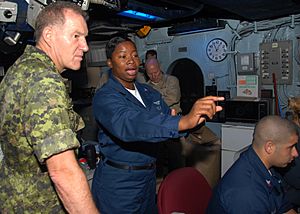
Today, women's involvement in aviation is still low. As of December 2019, only 5.4% of all certified civilian pilots in the United States were women. In Canada, as of December 2020, 8.15% of civilian pilots are women. However, 18% of women in the Royal Canadian Air Force now hold aviation jobs. The global average for women airline pilots is 3%.
Overall, in 2008, only 16% of women worked in aircraft and spacecraft manufacturing. Women made up only 25% of aerospace engineers in 2014. Less than 6% of senior executive positions in airline companies were held by women in 2015. Pakistani pilot Ayesha Farooq was the first female fighter pilot for the Pakistan Air Force. At least 19 women became pilots in that air force since 2003. India has been very successful at getting women to pilot commercial airliners. In 2014, women made up 11.6% of pilots there. Women say that strong family support helps them balance family and career. By 2012, China's PLAAF had trained over 300 female pilots and more than 200 support staff. Many have been trained to fly China's most advanced combat jets. In 2016, Wang Zheng (Julie Wang) became the first Asian woman to fly solo around the world.
In Japan, the first female captain for commercial passenger flights was Ari Fuji, who started flying for JAL Express in July 2010. In the Asia-Pacific region, there is a shortage of pilots. This is helping to reduce gender bias, leading to more women being hired. Vietnam Airlines has created flexible flight schedules to help with personal demands. EasyJet offers scholarships for women pilots to help with training costs. EVA Air actively recruits candidates from university programs.
In Africa, many trained pilots move to the Middle East or Asia for better career chances. Women Aviators in Africa was founded in 2008 to inspire young women to train in aviation. Estimates for women in the field are still below 6%. While there's a great need for rural aviation in Africa, there isn't enough support. Local efforts have succeeded in training bush pilots for transport, medical help, and policing. Efforts continue to increase the number of women pilots because women are less likely to move away if they find good jobs in their own communities. As of 2016, seven of the top ten fastest-growing aviation markets were in Africa. In 2022, Zara Rutherford became the youngest female pilot to fly solo around the world.
Challenges: Sexism in Aviation
Women often had to work extra hard to prove they were as capable as men. Clare Boothe Luce wrote, "Because I am a woman, I must make unusual efforts to succeed. If I fail, no one will say, 'She doesn't have what it takes.' They will say, 'Women don't have what it takes.'" Pioneer aviator Claude Grahame-White felt that women were "not 'temperamentally suited' to handle the controls of an airplane."
During the first National Women's Air Derby in 1929, women faced "threats of sabotage." Headlines even read, "Race Should Be Stopped." Because flying was seen as dangerous, many aircraft manufacturers in the late 1920s hired women as sales representatives and flight demonstrators. The idea was that if a woman could fly a plane, it couldn't be that hard or dangerous.
In 1986, a spokesperson for the Air Line Pilots Association, International said there were only two women Boeing 747 captains because "women in aviation are a relatively recent phenomenon and everything in the airlines industry is done by seniority." In 1927, Marga von Etzdorf became the world's first woman to fly for an airline, Lufthansa. However, in 1934, Helen Richey became the first woman to fly a commercial airliner in the United States. She quit after ten months because the all-male pilot's union wouldn't let her join, and she rarely got to fly. Airlines continued to discriminate against women until it became illegal due to the Civil Rights movement. In 1969, Jacqueline Dubut was hired by Air Inter and became the first female airline pilot after the Civil Rights movement.
Old ideas about men flying and women serving drinks have become deeply set. This forces women who want to fly to deal with negative attitudes from co-workers and society.
A 2005 survey found that many women pilots either didn't know about sexism against them or hadn't experienced it directly. However, many women believe that more women face prejudice than admit it.
Diversity in Training
In the past, women were often kept out of education. But after the Civil War, women were allowed to attend classes with men. More recently, the number of women going through education has greatly improved. In 1970, 42.3% of college students were women. This grew to 56.1% in 2007. This means women have more access to aviation training programs than ever before. So, the idea that women can't handle certain jobs is less valid. Women should have the same opportunities as men, given their skills and knowledge.
Unequal Pay and Career Growth
Wage inequality between men and women is a problem in aviation, just like in other industries. Women are often paid less than men, even with the same skills and experience. Also, the culture in the industry has often favored men for career advancement. Few women reach top positions in aviation, as many are held by men. Women have a harder time moving up the career ladder, while men often spend less time in lower positions before getting top jobs. To help fix these issues, more programs are being created. For example, A-WING is a program run by over 60 volunteers. It aims to teach young women about aviation job opportunities. The organization uses donations to create educational materials, speaking events, and networking chances. Their goal is to increase women in aerospace jobs by 25% by 2025, a goal they call "25 by 25." Such programs are becoming more common to help with career inequalities for women in aviation.
Solutions for Gender Equality
Affirmative Action
Studies show that affirmative action has encouraged women to become pilots. It has motivated women to take on challenges and enter this male-dominated field. Since this initiative has had some success, it's important to keep using it. This will make it easier for women to enter the aviation industry and move up to top management roles. A positive attitude and a change in culture are needed for men to change their views on women in aviation. They need to understand how their behavior affects pilots and why cultural evolution is important.
Funding for Training
Getting the necessary training and knowledge for aviation costs a lot of money. Research shows that these training fees are paid by parents, students, or through loans. Given the high cost of training and the lower starting incomes for women, it's important to offer incentives for their studies. Many aviation students drop out because of the high costs of qualifications, licenses, and the time involved. However, an increasing number of women's scholarships since the 1980s have not significantly increased the number of women in the industry.
Changing the Culture
Attitudes, stereotypes, and prejudices are deeply rooted in culture and have played a big part in inequality in aviation. It's important to educate men about how these attitudes affect women. They need to understand how their behavior impacts pilots and why the culture in aviation needs to change. Understanding these impacts helps build better relationships among diverse flight crews. Women also need to be encouraged to pursue these careers to fix the problem where they have been discouraged in the past.
See also
- Timeline of women in aviation
- List of women aviators
- Women of Aviation Worldwide Week
- Women in Aviation, International
- Ninety-Nines
Images for kids
-
Aida de Acosta, 1903 flying Alberto Santos-Dumont's airship N° 9
-
Wilbur and Katharine Wright seated in the Wright Model A Flyer with Orville Wright standing nearby in 1909. This was Katharine's first time flying. Her skirt is tied with a string.
-
Hélène Dutrieu, 1911
-
Miss Prim with airplane at the flight school Aero Material in Stockholm, Sweden, circa 1920
-
New York City clothing store B. Altman markets to women aviators in 1929.
-
Women pilots who escorted the landing of Amy Johnson in Sydney on 4 June 1930, at the end of the first England to Australia flight by a woman. Photo presented to the National Library of Australia by Miss Meg Skelton (on left).
-
Sabiha Gökçen, world's first female combat pilot
-
Stamp of Russia 2012 No 1567 Marina Raskova who flew in WWII
-
Margot Duhalde, the first woman pilot of the French Air Force
-
Female mechanics working on R-1830 of PBY at NAS Corpus Christi 1942
-
The Korean War offered new opportunities in critical roles for women marines, like these control tower air traffic controllers.
-
Stewardesses from 1968 working for United Airlines
-
Valentina Tereshkova, the first woman in space and the first to orbit the Earth, on a Russian stamp
-
Jerrie Mock's Spirit of Columbus, which she piloted in 1964 as the first woman to fly solo around the world, at the Steven F. Udvar-Hazy Center
-
Air Traffic Controller 1st Class Erica Banks explains the SPN 43 Radar System to General Walter Natynczyk, Canadian chief of Defense Staff, in the amphibious air traffic control center aboard the amphibious assault ship USS Bonhomme Richard.



